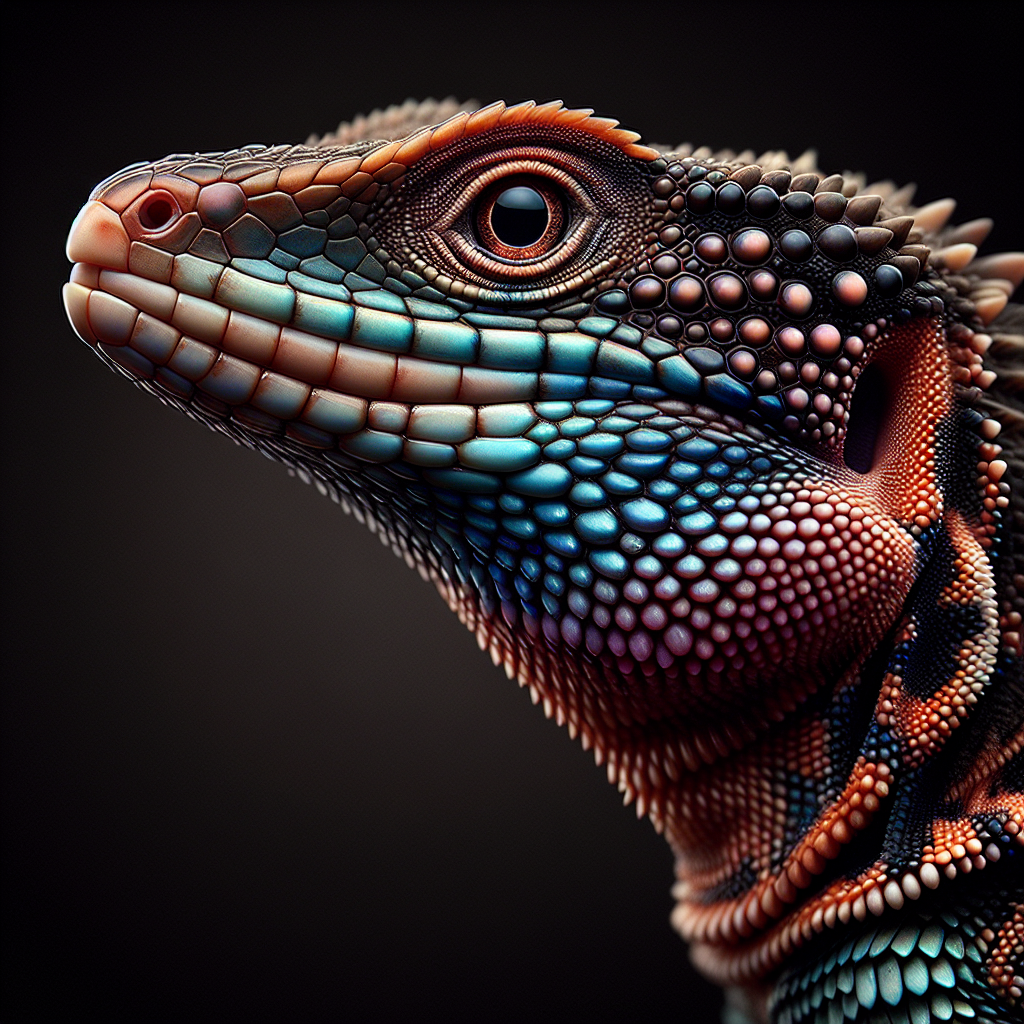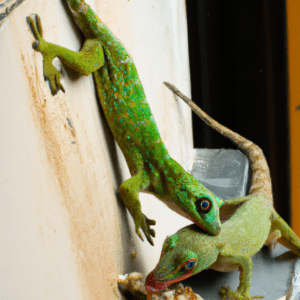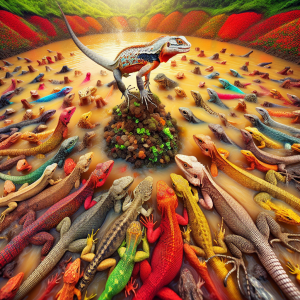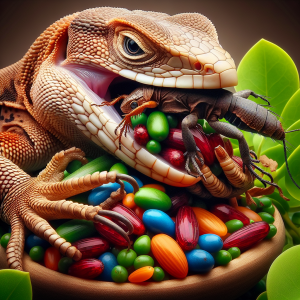Introduction: Importance of Varied Diet for Pet Lizards
Imagine you’re standing in a pet store, staring at the rows of lizard food options, feeling overwhelmed by the choices. You know your scaly friend deserves the best, but how do you choose? Enter the concept of offering variety in your lizard’s diet. It’s not just about mixing things up for the sake of it; there are real benefits to diversifying what your lizard eats.
When I first started researching about this topic, I was amazed to learn how crucial a varied diet is for the health and well-being of our reptilian companions. It’s not just about keeping things interesting for them (although who doesn’t love a little culinary adventure now and then?), but it’s also about ensuring they get all the essential nutrients they need to thrive.
Did you know that different lizard species have distinct dietary requirements? Just like us humans, lizards have specific nutritional needs based on their species, age, and size. By offering a variety of foods, you can tailor their diet to meet these unique requirements and promote their overall health.
Now, here’s a fascinating fact: Did you know that some lizards are picky eaters? Yes, it’s true! Introducing new foods to your lizard’s diet can sometimes be a challenge, especially if they’re used to a particular type of food. But fear not, there are tips and tricks you can use to gradually expand their palate and ensure they’re getting a well-rounded diet.
So, imagine the joy of watching your lizard eagerly munch on a new type of treat, knowing that you’re providing them with a nutritionally balanced meal. By offering variety in your lizard’s diet, you’re not only keeping mealtime exciting but also contributing to their overall health and happiness. It’s a win-win situation for both you and your scaly friend!
Benefits of Offering Variety in Lizard Diet
Imagine this – you’re sitting down to feed your pet lizard, and instead of the same old meal every day, you offer a variety of foods. It’s like a mini buffet for your scaly friend! That’s the beauty of providing a diverse diet for your lizard – it’s not just about keeping things interesting for you, but it’s also incredibly beneficial for your pet’s health.
Now, let me share an interesting fact about the benefits of offering variety in a lizard’s diet. Did you know that different foods contain a variety of essential nutrients that your lizard needs to thrive? By incorporating a range of foods such as insects, leafy greens, fruits, and even the occasional treat like mealworms or crickets, you can ensure that your lizard receives a well-rounded diet that meets all their nutritional requirements.
Think about it this way – if you were to eat the same meal every single day, you’d probably get bored pretty quickly, right? Well, lizards are no different! Offering a varied diet not only prevents mealtime monotony but also helps prevent nutritional deficiencies and encourages natural foraging behaviors in your pet.
So, the next time you’re planning your lizard’s menu, consider mixing things up a bit. Experiment with different food options, colors, and textures to keep mealtime exciting and nutritious for your scaly companion. Your lizard will thank you with their vibrant colors, energetic behavior, and overall well-being.
Types of Foods Suitable for Lizards
When it comes to types of foods suitable for lizards, it’s like putting together a diverse buffet for our scaly friends. Just like how we humans need a variety of nutrients from different food groups, lizards also benefit from a well-rounded diet.
Imagine walking into a lizard restaurant – you’d find an array of options tailored to suit their dietary needs. From leafy greens and vegetables to insects and fruits, there’s a whole menu waiting to be explored. Each food item serves a purpose in providing essential vitamins, minerals, and proteins crucial for your lizard’s health.
Picture this: your lizard companion eagerly exploring a plate full of crickets and mealworms, savoring each bite with gusto. It’s fascinating to see how their natural instincts kick in when presented with a selection of foods that mimic their wild diet.
Incorporating an interesting fact about lizard diets – did you know that some lizard species are strictly herbivores, while others are carnivorous or omnivorous? This diversity in dietary preferences reflects the unique needs of each lizard species and underscores the importance of offering a varied diet to meet their specific nutritional requirements.
As a responsible lizard owner, it’s essential to understand the nutritional needs of your pet and provide a balanced diet that caters to their individual preferences. By offering a mix of foods such as leafy greens, vegetables, fruits, and live insects, you can ensure that your lizard receives a well-rounded diet that promotes their overall well-being.
So, the next time you’re planning your lizard’s mealtime, think of it as curating a special culinary experience for your scaly friend. With a bit of creativity and knowledge about suitable foods, you can turn feeding time into a delightful adventure that nourishes both body and soul.
How to Create a Balanced Diet Plan
I’m really excited to talk to you about creating a balanced diet plan for your pet lizard. It may sound complicated at first, but trust me, it’s not as daunting as it seems.
Let me share a personal anecdote with you to illustrate the importance of a well-rounded diet for lizards. When I first got my bearded dragon, I thought feeding him only crickets would be enough. However, I soon learned that offering a variety of foods is crucial for his overall health and happiness.
Now, when it comes to creating a balanced diet plan for your lizard, it’s essential to consider the nutritional needs of your specific lizard species. Different types of lizards have varying dietary requirements, so it’s important to do your research and tailor their diet accordingly.
One interesting fact to keep in mind is that lizards can be picky eaters, just like humans! Some lizards may prefer certain types of foods over others, so it’s essential to experiment with different options to see what your pet enjoys the most.
To ensure that your lizard is getting all the necessary nutrients, you’ll want to include a mix of protein sources, vegetables, fruits, and even the occasional treat. This variety not only keeps your lizard healthy but also prevents them from getting bored with their meals.
When introducing new foods to your lizard, be patient and gradual. A sudden change in diet can upset their stomach or lead to refusal to eat. Start by offering small amounts of new foods alongside their regular diet and observe how they respond.
Remember, monitoring and adjusting your lizard’s diet is an ongoing process. Keep an eye on their weight, energy levels, and overall health to determine if any changes need to be made to their diet plan.
By providing a varied and balanced diet for your pet lizard, you are not only promoting their health and well-being but also enriching their lives. So, get creative with their meals and watch your lizard thrive!
Nutritional Requirements for Different Lizard Species
When it comes to the nutritional requirements of different lizard species, it’s fascinating how their diets can vary so widely. I remember when I first started researching what to feed my bearded dragon, I was surprised to learn about the specific needs of these unique reptiles. Each species has its own set of dietary requirements based on factors like size, age, and natural habitat.
For instance, did you know that some lizards are primarily herbivores, while others are insectivores or omnivores? It’s incredible how their diets align with their evolutionary adaptations. Understanding these distinctions is crucial for providing the best care for your scaly friend.
One practical tip I found helpful is to research the specific nutritional needs of your lizard species. For example, if you have a leopard gecko, you’ll need to provide a diet rich in insects like crickets and mealworms, along with some fruits and vegetables. On the other hand, if you own a green iguana, their diet should consist mainly of leafy greens and vegetables.
It can be a bit overwhelming at first, but once you get the hang of it, creating a balanced diet plan for your lizard becomes second nature. Incorporating variety into their meals not only ensures they receive all the necessary nutrients but also keeps mealtime exciting for them.
Have you ever faced any challenges when trying to establish a diverse diet for your lizard? It can be tricky finding the right balance, but with a bit of research and experimentation, you’ll soon discover what works best for your scaly companion. Remember, a varied diet is key to promoting their overall health and well-being.
By tailoring your lizard’s diet to their specific needs, you’re not only providing them with the best care possible but also enriching their lives in ways you may not even realize. It’s amazing how something as simple as offering a variety of foods can have such a positive impact on their health and happiness.
Tips for Introducing New Foods to Your Lizard
So, when it comes to introducing new foods to your lizard, it can be a bit of a trial-and-error process, but trust me, it’s worth it in the end. I remember when I first tried giving my bearded dragon some diced fruits, thinking he would love them. To my surprise, he turned up his nose and gave me this look like, “What is this?” It was quite a funny moment, but it taught me an important lesson about understanding a lizard’s preferences.
You know, lizards can be quite picky eaters, so the key is to introduce new foods gradually. Start by offering small portions of a new food alongside their regular diet. It’s like a little culinary adventure for your scaly friend! Observe how they react to the new food. Are they curious? Do they sniff it or show interest? Sometimes, it may take a few tries before they decide to give it a taste.
One interesting fact about introducing new foods to lizards is that some species have evolved to prefer specific types of food based on their natural habitat. For example, iguanas are herbivores and thrive on a diet rich in leafy greens and vegetables. On the other hand, geckos are insectivores and enjoy a diet of live insects like crickets and mealworms. Understanding your lizard’s natural dietary preferences can help you choose the right foods to offer.
Now, here’s a practical tip for you: try varying the texture and presentation of the food. Lizards are visually stimulated creatures, so presenting food in different ways can pique their interest. You can try offering fruits in cubes, slices, or even pureed form. For insects, you can offer them live, dried, or gut-loaded with nutritious supplements.
By taking the time to introduce new foods slowly and thoughtfully, you’re not only expanding your lizard’s palate but also providing them with a well-rounded and nutritious diet. Remember, every lizard is unique, so don’t be discouraged if they don’t immediately take to a new food. Patience and persistence are key when it comes to broadening your scaly friend’s culinary horizons!
Common Mistakes to Avoid in Feeding Pet Lizards
Have you ever had a moment of panic when you realized you may have been feeding your pet lizard incorrectly? I’ve been there, and let me tell you, it’s not a fun experience. It’s important to be aware of the common mistakes to avoid in feeding pet lizards to ensure their health and well-being. Picture this – you’ve spent time researching the best foods for your lizard, carefully preparing their meals, only to find out that you’ve been unintentionally harming them by making a few simple errors. It’s a situation no pet owner wants to find themselves in.
One interesting fact to note is that some foods that are perfectly fine for humans can be harmful or even toxic to lizards. For example, feeding your lizard insects that have been exposed to pesticides can have detrimental effects on their health. It’s crucial to be mindful of the quality and source of the food you provide to your scaly friend.
When it comes to feeding pet lizards, one practical tip is to always ensure that the food you offer is appropriately sized for your lizard’s species and age. Large food items can pose a choking hazard or be difficult for your lizard to digest, while tiny prey may not provide enough nutrition. Finding the right balance in food size is key to promoting your lizard’s health.
Now, let me ask you this – have you ever considered the broader implications of feeding your lizard incorrectly? The impact of a poor diet can extend beyond just physical health; it can also affect your lizard’s behavior and overall quality of life. By being mindful of what you feed your scaly companion and avoiding common feeding mistakes, you’re not just ensuring their well-being – you’re also fostering a stronger bond and connection with your pet. So, let’s feed our lizards right and watch them thrive!
The Role of Supplements in a Lizard’s Diet
Have you ever wondered about the role of supplements in your lizard’s diet? It’s a topic that often sparks curiosity among reptile enthusiasts. Let me share an interesting fact with you – did you know that certain lizard species have specific dietary requirements that may not be met solely through their regular food intake? This is where supplements come into play.
Imagine this scenario: You’ve been diligently feeding your lizard a varied diet, but you start noticing signs of nutrient deficiencies or health issues. This is where incorporating supplements can make a significant difference. It’s like giving your lizard a little boost to ensure they are getting all the essential vitamins and minerals they need to thrive.
Choosing the right supplements for your lizard can be a bit overwhelming at first. There are various options available in the market, from calcium powders to multivitamin supplements. The key is to do your research and consult with a reptile specialist to determine the best supplement regimen for your specific lizard species.
Now, here’s a practical tip to keep in mind when it comes to using supplements: moderation is key. Just like with any dietary addition, you don’t want to overdo it. Too much of a good thing can sometimes have negative effects. Follow the recommended dosage instructions and monitor your lizard’s response to the supplements.
When thinking about the broader implications of incorporating supplements into your lizard’s diet, it all comes down to promoting their overall well-being. Just like humans take vitamins to support their health, supplements can help bridge any nutritional gaps and ensure your lizard is living its best life.
So, next time you’re planning your lizard’s meals, consider how supplements can play a vital role in maintaining their health and vitality. It’s a small addition that can make a big difference in the long run.
Monitoring and Adjusting Your Lizard’s Diet
Have you ever found yourself puzzled about what your lizard should be eating? It can be a tricky balance to strike, but fear not, my friend, because I’ve got some top tips for monitoring and adjusting your lizard’s diet.
Let me share a personal anecdote with you. When I first got my bearded dragon, I was overwhelmed by the conflicting advice on what to feed him. Some sources said one thing, while others said something completely different. It was a real challenge to figure out the best diet for my scaly friend.
One essential tip I learned along the way is the importance of monitoring and adjusting your lizard’s diet. Just like us, lizards have different preferences and nutritional needs. By observing your lizard’s eating habits and overall health, you can tailor their diet to ensure they are getting the right balance of nutrients.
For instance, if you notice that your lizard is gaining or losing weight unexpectedly, it could be a sign that their diet needs adjusting. Maybe they need more protein or fewer fruits in their meals. By keeping a close eye on their behavior and physical condition, you can make informed decisions about what adjustments to make.
Another key aspect of monitoring and adjusting your lizard’s diet is keeping track of any changes you make. It’s essential to note down what you feed your lizard and how they respond to it. This record-keeping can help you identify patterns and trends over time, allowing you to fine-tune their diet for optimal health and well-being.
Remember, every lizard is unique, so what works for one may not work for another. By staying attuned to your lizard’s needs and being proactive in adjusting their diet as necessary, you can ensure they are happy, healthy, and thriving. So, don’t be afraid to experiment and make changes – your scaly companion will thank you for it!
Conclusion: Promoting Health and Wellness Through Diet Variety
Have you ever wondered about the role of supplements in your lizard’s diet? It’s a topic that often sparks curiosity among reptile enthusiasts like us. Let me share some insights that might surprise you.
Supplements play a crucial part in ensuring that our scaly friends receive all the essential nutrients they need to thrive. Just like humans take vitamins to supplement their diets, lizards can benefit from certain supplements to fill any nutritional gaps in their meals. It’s like giving them a little boost to support their overall health.
I remember when I first introduced supplements to my bearded dragon, Spike. At first, I was a bit hesitant, unsure if it was necessary or even safe. But after doing some research and consulting with a reptile specialist, I learned that supplements could indeed enhance Spike’s diet, especially in terms of calcium and vitamin D3.
One interesting fact about supplements for lizards is that different species have varying requirements. For instance, while some lizards might need extra calcium to support their bone health, others may benefit more from vitamin A or multivitamin supplements. Understanding your specific lizard’s needs is key to providing the right kind of supplementation.
One practical tip I picked up along the way is to always consult with a reptile veterinarian or expert before adding any supplements to your lizard’s diet. They can offer valuable guidance on the types and amounts of supplements that are appropriate for your pet, ensuring that you’re not inadvertently causing harm with good intentions.
So, the next time you’re considering supplements for your scaly companion, remember to do your research, seek professional advice, and tailor the supplementation to meet your lizard’s individual requirements. With a balanced approach, you can help your reptile friend stay healthy and happy for years to come.




